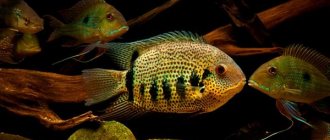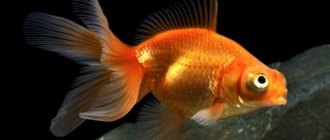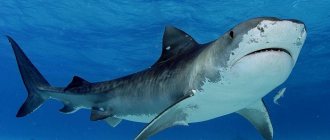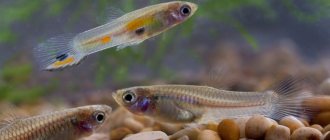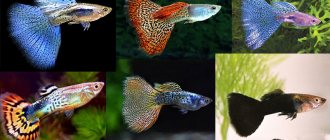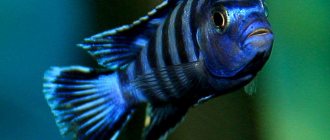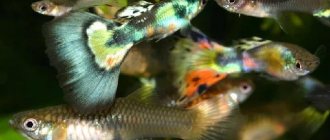Severum
Cichlids
Simplicity of content:
Latin name: Cichlasoma severum, Heros severus
Lifespan: 15 years
Maximum size: in nature – 30, in an aquarium – about 20 cm.
Average cost: 500 - 2000 rubles.
The colorful severum fish attracts many aquarists not only with its bright appearance, but also with its longevity and ease of care. There are a large number of representatives of this genus, differing in different colors.
Description
The fish have a not too elongated body, slightly flattened on the sides. If the aquarium is very spacious, then cichlazoma severum can be close to a disk in body shape. In the natural environment, the size of the fish reaches twenty centimeters, and in an aquarium it does not exceed fifteen centimeters. The anal and dorsal fins are long, reaching the base of the caudal fin.
The color of cichlases can be greenish, yellow or colorless. If there is no dominant gene in the fish's genome, then Cichlazoma severum becomes an albino. The fish's lips are thick, and its body, especially the gills and head, are decorated with line drawings. The species of cichlazoma severum “Red Pearl” (or Gold) has a golden body with a bright orange dotted pattern. This selection form is considered the most elegant. The color of Cichlazoma severum inirida is also interesting: a scattering of silvery spots shimmers against a dark background, which in clusters look like wide vertical stripes.
Representatives of the sexes are distinguished by color intensity. Males have brighter colors and larger sizes. In addition, their fins end in longer braids.
Cichlazoma severum is a monogamous, territorial fish. In an aquarium, with proper care, it lives up to fifteen years, and cichlazoma reaches sexual maturity at three years.
Gender Differences
The male is larger than the female and more brightly colored. Other differences characteristic of the entire family are also characteristic, namely, the dorsal and anal fins of the male are large in size and their ends are elongated into peculiar braids. During spawning, the male individual develops an anal tubercle shaped like a cone. In the female, this tubercle is a truncated pyramid.
- Why does a cat need a mustache?
- Rescue dogs
- Hypoallergenic cats
- Why does a cat need a tail?
- Chinchilla
- Dog breeds
Introduction
Translated from Latin, the word “severum” means “severe” or “restrained,” which clearly outlines both the appearance of the animal and the characteristics of its temperament. The fish is distinguished by a large dense body, filled with dark brown shades with a bronze sheen, characteristic small speckling on the body and extensive spots at the base of the caudal fin. The original form is characterized by malachite-black dorsal and caudal fins, a dark anal fin, with a reddish mark at the base. Thanks to constant selection, the color variations of severums, as well as their brightness, can vary significantly.
The habitat of this species appears to be the northern regions of the Amazon River, although relatively recently they were introduced and perfectly settled in the Nevada River basin. The natural size of an individual ranges from 20 to 30 cm, however, in the conditions of an artificial biosystem, severums rarely reach more than 20 cm. The body, compressed from the sides, is perfect for maneuvering among dense vegetation and fallen tree branches, which, in fact, is the natural landscape of their environment a habitat.
Kinds
To date, such a number of severums of various colors and sizes have been bred through selection that some of them are not even divided into separate species. Selection forms are crossed with each other, obtaining more and more new subspecies. The most popular varieties are: red pearl severum, blue emerald (santarem), gold, red shoulder (rottail), green Guyana severum.
Red pearl
Severum red pearl (red-spotted) is a peaceful, golden-colored fish with many red spots. The color of the scales can vary from pale yellow to rich red (due to the large number of scarlet spots). Cichlazomas severum red pearl are not shy and love to study the world around them, leisurely contemplating everything around them. However, during spawning, the behavior of Cichlazoma severum red pearl changes dramatically. The fish zealously defends its territory and enters into numerous skirmishes with its fellows.
Blue emerald
Blue emerald is colored blue or blue with an emerald tint. It is not difficult to distinguish males from females. Black stripes on the sides in infancy, turning into spots with age, indicate male sex.
Gold
Golden severum is a light yellow aquarium fish with a golden tint. It does not have any stripes or pronounced spots. In males, the golden color turns orange. This species also includes albinos with soft pink scales and reddish eyes.
Redshoulder
Redshoulder (rottail) is one of the most prominent representatives of the severums. It appeared in our country recently, but is already very fond of aquarists for its unusual color, unpretentiousness in maintenance and gentle disposition. The body of this fish is silvery or greenish in color, and behind the gills there is a spot of red, sometimes orange. Males have a brighter color, and dark spots are scattered across the body and forehead. Females have a uniform color. Like other cichlid species, it shows aggression during spawning.
Green
Green severum (Gayana) has yellowish or green scales. Males have black spots all over their bodies, with stripes of the same color running down their sides. Females have a uniform color. Unlike other fish of this species, the green severum prefers to live in the lower and middle layers of the water.
Behavior
Pisces are calm, unfussy - contemplators, intellectuals and philosophers. They recognize the owner and easily get used to the fact that he pets them and feeds them by hand.
A stranger who puts his hand into an aquarium may be severely hit or bitten.
Some fans of this species claim that the fish are able to communicate with each other using dull guttural sounds, reminiscent of tapping, which can be heard when being near the aquarium.
Considered less aggressive than most cichlids, aggression is directed primarily at individuals of their own species. Moreover, it can be shown not only by males to other males, but also by females to females.
They form stable pairs or triplets - one male and two females; they prefer to choose their own partners. An established family secures a certain territory, which it strives to expand over time, sometimes gradually occupying the entire aquarium and displacing all other fish.
Diseases
With proper care and a balanced diet, cichlazoma rarely gets sick.
Poor quality water and/or new fish can cause infection with ichthyophyriasis. The causative agent of the virus is an equiciliated ciliate. Main features:
- the appearance of whitish tubercles covering the body;
- loss of appetite;
- changes in behavior (pets become fearful, move less);
- scratching the abdomen on the ground.
The first aid for this disease is to gradually increase the water temperature. Then the water is replaced by removing liquid from the bottom and adding fresh water. If possible, sick individuals are placed in a separate container. There are also many special preparations that disinfect the environment and destroy parasites.
Poor living conditions cause the development of head erosion in severum. It is determined by the appearance of a pit on the pet’s head. The cause of the disease is a monotonous diet and lack of vitamins. Untimely water replacement can also cause erosion.
Quarantining new specimens will help reduce the risk of disease in aquarium inhabitants. Beginners should be allowed into the aquarium only after making sure there are no infections.
Nutrition
These fish are omnivores. They eagerly eat live food, including ice cream. Dry food, chips, and substitutes will also not be left without attention. Their diet must necessarily include plant foods, which can be achieved by purchasing appropriate feed or feeding inexpensive plants - for example, duckweed. You can also give scalded lettuce and spinach leaves.
Feeding aquarium fish should be correct: balanced, varied. This fundamental rule is the key to the successful keeping of any fish, be it guppies or astronotuses.
Feeding fish should not be monotonous; the diet should include both dry food and live food. In addition, you need to take into account the gastronomic preferences of a particular fish and, depending on this, include in its diet food either with the highest protein content or, conversely, with plant ingredients.
Feeding
The fish are omnivores and will eat all types of aquarium fish food. The basis of feeding can be made from sinking tablets for large cichlids (preferably containing fiber, such as spirulina).
Additionally, provide live or frozen food: both large ones - earthworms, shrimp, fish fillets, and small ones - tubifex, bloodworms, gammarus.
It is especially important to feed with plant foods, since fish in nature mainly consume them. This can be either special food or pieces of vegetables - cucumber, zucchini, lettuce.
There is no need to feed mammalian meat such as beef heart frequently. Such meat is poorly digested by the fish’s stomach and leads to obesity and disease.
It is better to feed cichlase in small portions twice a day, being careful not to overfeed, as the fish are prone to gluttony.
Reproduction of severums
Just like most cichlids, representatives of the described species lay eggs on smooth surfaces (stones, leaves, aquarium glass). In the process of preparing the substrate, producers actively move pitfalls, pots, and pluck out plants. Thus, the fish clear the area around the future clutch. The reproduction of severums is accompanied by an increase in aggressiveness; they actively drive away not only representatives of their own species, but also other fish from their territory. Occasionally, disagreements arise between the male and female, then they begin to measure their strength, locking their mouths. As a rule, the female lays up to a thousand yellowish egg-shaped eggs with a diameter of 1 mm. The male then fertilizes them. During the process of maturation of the clutch, producers pluck out unfertilized eggs and dip the remaining ones with fins.
Recently, there has been a decrease in the parental instinct in severums, which is primarily due to the large-scale use of incubators for maturation of eggs. This leads to the fact that parents are not allowed to care for their eggs, and if in the case of non-parental producers they could eat their eggs, thereby leaving no offspring, then incubators allow the fry to be raised, preserving signs of weak parental instinct. It can be recommended to leave the first fry to their parents, checking their instincts.
Severum larvae hatch on about 3 days, depending on the temperature. A week later, the fry “takes wing” and begins to look for food for a larger faction. At this stage, he needs daphnia, rotifers, brine shrimp, etc. At first, the fry develops extremely slowly and reaches a centimeter only in the first month. They are starting to look like "true" discus fish with their tall, flattened bodies. Thanks to the dark color and a number of vertical lines, the fry are well camouflaged against the background of vegetation. By about three months, severums are already able to consume tubifex, bloodworms, and chopped earthworms. But you shouldn’t pamper them with bark, since the latter does not have a sufficient composition of nutrients. The camouflage of the fry dissipates around the first year of existence. Sexually mature individuals, as a rule, lack vertical stripes and have only one line near the tail.
Breeding
Spawning of severums is typical for all cichlases. Fish become sexually mature at the age of 1.5 – 2 years. The couple forms independently. To breed severums, you need a flat surface in the aquarium. Severus digs a hole or clears a flat surface in the tank - a rock or stone - on which the eggs can be laid. The spawning of severums is preceded by beautiful courtship, such as lip locking and tail slap. Spawning can be triggered by raising the temperature by several degrees and replacing ¼ of the water in the aquarium 2-3 times a week . To ensure breeding success, slowly lower the pH to around 6.2. Fertilized eggs are light brown, while unfertilized eggs will turn white in 1-2 days. The male and female will protect the eggs.
Video: breeding severums
3-5 days after the eggs are laid and fertilized, the larvae hatch. In a week they will turn into fry and swim freely. The fry are fed microplankton and artemia. The color will be formed when the fry reaches a size of 1 cm.
Cichlazoma severum contents
Keeping the cichlazoma severum species is relatively easy. You need to pay due attention to the volume and height of the aquarium. It should also be taken into account that you should purchase a flock of seven or ten individuals. After pairs are formed, the extra fish should be resold or given as a gift to someone you know.
Aquarium volume
Cichlazoma severum is a large and territorial fish, which means that the minimum volume per pair should be at least 130 liters. In addition to the volume, the shape of the dwelling allocated to it is important for this species. So in a tall vessel, its body will take a shape closer to a disk. A low and wide dwelling, on the contrary, will lead to elongation of the body.
Priming
It does not impose any special requirements on the soil. But it is better to use granite chips and small pebbles. For some ideas, artificial soil may be useful. It is better to use its medium and large fraction. At the bottom there must be large stones forming artificial boundaries. It is better to install them standing, imitating rocks. You should also install several stones in such a way that their plane is inclined at a certain angle to the horizon. You can use prepared driftwood, simulating driftwood in natural habitats.
Plants
Like all cichlids, they are not indifferent to plants, but if you pick up large plants with hard leaves, they will most likely remain intact. In nature, cichlazoma severum loves to hunt for small crustaceans in plant thickets. It can also eat the plants themselves. If you cannot create thickets of living plants, you will have to create an imitation of them from plastic dummies.
You can try using spiral vallisneria, fast-growing Elodea canadiana, large species of cryptocorynes, pinnately, and hornwort. Thickets, whether live or artificial, will help small fish to hide from the aggression of larger specimens when dividing the territory after pairing. The fish that have not found their place in the sun in this aquarium will sit out almost painlessly in thickets or caves, waiting for you to find an opportunity to transfer them to another aquarium or find them a new owner.
Water parameters
The temperature of the environment for keeping is from 22 to 24 degrees Celsius. Hardness from 10 to 20 °dH. pH – 6.5 – 7.5. Fish love old water, but you should still change about 30% of the water volume at least once a month.
Lighting
It is determined not so much by the needs of the fish as by the needs of other inhabitants of the aquarium, in particular plants. You should focus on the total power of fluorescent fluorescent lamps with a total power of 0.3 to 0.5 W/l.
Aeration and filtration are necessary for housing with these fish. This is due to the increased metabolism of this species. Therefore, when equipping a home for cichlazoma severum, be sure to equip it with systems of additional artificial aeration and water filtration. It is also necessary to siphon the bottom regularly, at least once a week, removing the waste products of your pets.
Interesting Facts
- The shape of cichlas severum is greatly influenced by the shape of the aquarium. In a high container, the fish grow wider; in a narrow container, their body becomes longer.
- As they adapt to life in an aquarium, cichlazoma severum secretes less and less skin secretion, which the fry feed on. Therefore, babies are often raised in separate aquariums.
- Cichlazomas severum can form pairs of same-sex individuals (two females). But such couples do not produce offspring.
Compatibility with other fish
Should be kept with fish of similar behavior and size. Small fish are perceived as food. Although American cichlids are less aggressive than African cichlids, it is still important to keep the aquarium spacious. Then they will have their own territory to protect. Their own place and large neighbors significantly reduce the aggressiveness of cichlids.
They get along well with other small cichlids - black stripe, meeka, bee. The same with catfish - veiled synodontis, plecostomus, sacbranchial.
Video
Epilogue
Although Cichlazomas severum are not currently in trend, these fish can be categorically recommended for populating spacious office aquariums in which discus fish cannot survive without proper care, and small fish are simply lost.
Having an impressive size, interesting shape and color, and having a calm and peaceful character, Cichlazomas severum can be kept in a wide variety of species communities.
Based on the above, Cichlazomas severum are very promising fish. There are practically no weaknesses in their maintenance and breeding, and even those that exist are more than offset by the inherent advantages of the fish.
And their unpretentiousness to keeping conditions, ease of breeding and interesting behavior make these fish ideal objects for neophyte aquarists. Well, those lovers for whom the above is not enough can appreciate the ability of severums to make tactile contact - they can easily be tamed to take food from their hands and allow themselves to be stroked.
Such direct contact puts the cichlid severum on the same level as other pets and can bring a lot of pleasure to children.
